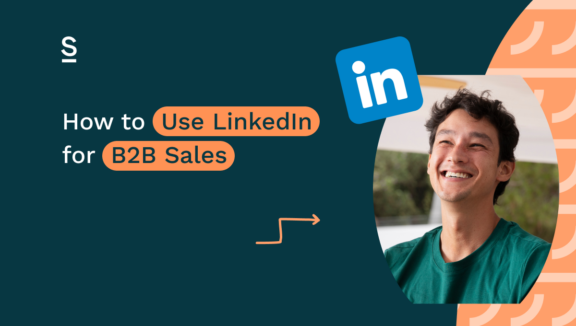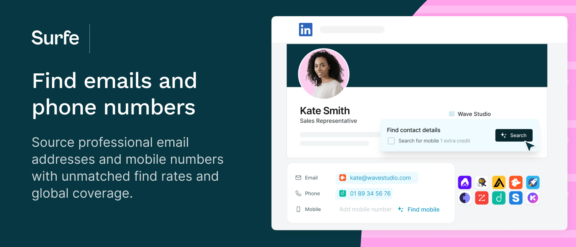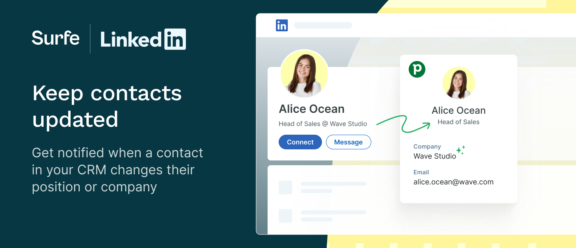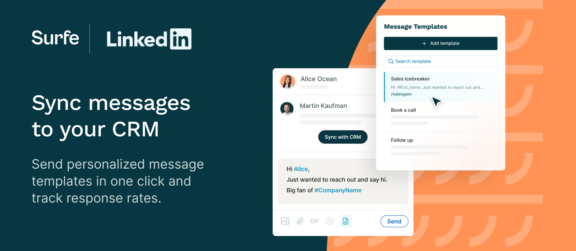How to Use LinkedIn for B2B Sales

Think back to your first days at your job.
Learning about your ICP. Meeting your boss – and their boss. Getting to grips with a new CRM. Having a crash course in your industry. Figuring out targets for a work best friend.
What about using LinkedIn?
If you’re in B2B, chances are you were using it before you started and didn’t get any training. Or if not, you got a quick runthrough of how to use LinkedIn Sales Navigator. Whatever it was, we’d put money on any LinkedIn training being somewhere between perfunctory and non-existent.
Here’s the thing: if you’re not taught how to use LinkedIn properly, you’re missing out on a huge opportunity. 75% of B2B buyers and 84% of C- or VP-level execs use social media to make a purchasing decision. And 4 out of 5 people on LinkedIn have a say in these decisions.
In the world of B2B sales, where you need a multi-touch, multi-channel strategy targeting several profiles per sale, LinkedIn isn’t just a nice-to-have. It’s a necessity when it comes to influencing purchases.
If you’re not sure if you’re making the most of it, we’ve got you. Whether you’re questioning if you’re using it correctly, you think you might be wasting time on ineffective strategies, or you’re not sure you’re making the most of it, keep reading.
In this blog, we’ll cover advanced strategies for leveraging LinkedIn in the B2B sales process. Take a peek:
- Advanced lead generation on LinkedIn
- Finding and verifying contact information
- Integrating LinkedIn into your sales workflow
- Enhancing outreach and engagement
- Leveraging LinkedIn for social selling
Ready? Let’s go 👇
Advanced lead generation on LinkedIn
When you think about it, the opportunity LinkedIn presents is mind-blowing. Where else do you have access to an almost unlimited list of people you could sell to, and insights into what they’re interested in, what their problems are, and what’s happening in their industry?
Amazing, yes – but it can be overwhelming if you don’t know where to look. You might find this type of information by:
- Following events your leads are interested in, and scraping attendees into a list
- Keeping an eye on your competitors, to see what they’re talking about and who they’re partnering with
- Seeing what type of content your leads engage with, and checking out others doing the same
- Using the search function (old school!) to find new people to engage with. Tip: the ‘people also searched’ or ‘related companies’ sections here can be gold dust.
And that’s before we’ve even started on LinkedIn Sales Navigator. Without further ado, let’s get into it.
Using LinkedIn Sales Navigator for targeted prospecting
Here’s how to get the best out of LinkedIn Sales Navigator:
Targeted prospecting: the tool has advanced filters for you to identify the best-quality leads. Filter by job title, function, location and seniority – or by company revenue, headcount team size and industry.
Building lead lists: once you’ve used filters to build a list of potential prospects, you can make selections and save them to lead lists. Come back to these at a later date using the ‘lead list’ tab. Plus, you can take notes on your leads and track the InMails you’ve sent them.
Leveraging insights and data
Market trends and insights: it’s not just for prospects – you can use LinkedIn to understand the wider market, and paint a clearer picture of your ICP. Use Sales Navigator alerts to keep an eye on job changes and promotions – and cross-reference them with other data points to build a clearer picture of your landscape.
Engagement metrics: check what InMails are performing well – using engagement metrics like your acceptance rate – to gauge interest levels.
Finding and verifying contact information
Another awesome thing about LinkedIn (can you tell we really love it yet?) is that when it comes to finding the relevant information you need, half the work’s already done for you.
Click on a profile, and you’ll be able to see when this person last got promoted, what their job history is, what type of content they care about, and what they had for dinner. We’re only half-joking about that last one.
Making the most of these insights is really easy when you’re in the know. All it takes is an easy-to-use tool that can sync them automatically to your CRM, and populate their entries with contact data. What on earth could we be talking about?
Surfe’s intelligent email finder
Spoiler alert, it’s Surfe! Let’s run through how our email finder for LinkedIn can help – after all, data migration is our bread and butter (one of them, anyway).
Surfe aggregates multiple contact databases (think Apollo, Dropcontact, RocketReach and Hunter – you know, all the good ones) to achieve a 93% email find rate. It also triple-checks this data is accurate by using ZeroBounce: no more undelivered emails or bouncebacks.
Bulk exporting from LinkedIn Sales Navigator with Surfe
Surfe also takes away the faff of exporting lead lists from LinkedIn Sales Navigator. You can do it in bulk, with one click – here’s how:
- Build a target lead list. Thanks to the tips above, you should already be a pro!
- Select the leads you want, and click ‘Add as contact’.
- Your new contacts will automatically pull through to your CRM of choice – email addresses and phone numbers included. It only takes one click!
The importance of accurate data
Populating your CRM with accurate data is really, really important. The last thing you want is to be relying on something that’s out of date, or just plain wrong. Doing so could waste your time (no thanks), result in an undelivered email (nah) or lead to an awkward interaction with a prospect (absolutely not).
The good news? Surfe keeps an eye on any updates you need to be aware of – job changes, for example – and automatically updates your CRM where you need to. Dreamy!

Integrating LinkedIn into your sales workflow
So, how do you introduce all your new LinkedIn skills into your workflows – without creating a load more work for yourself?
CRM integration with LinkedIn
The answer lies with Surfe – we’re multi-talented (if we do say so ourselves). Here’s how to connect your CRM of choice with LinkedIn:
- Download the Surfe Chrome extension – it’s free!
- Surfe will open LinkedIn. Once you’re there, press ‘get started.’
- Surfe will ask you to choose the CRM you want – that could be Hubspot, Salesforce, or Pipedrive, to give you a couple of examples.
- Head back to LinkedIn, and give Surfe permission to access the CRM. You’re done!
So now it’s connected, what can you expect?
As well as contact data, Surfe also syncs LinkedIn interactions – like DM or InMail – with your CRM, so you can easily keep track of who you’ve spoken to and when.
All these syncs are automatic, and happen in real-time, so you can be confident you’re always working with up-to-date data.
As we’ve mentioned before, this data is the key to making every interaction count.

Enhancing outreach and engagement
We all know the key to outreach success is 1) relevance and 2) personalisation. But how do you do this when you’re 1) pressed for time and 2) have punchy targets to hit?
Personalized outreach strategies
LinkedIn InMail and Message templates
Templates are the key to reaching out at scale – and Surfe can help! Just save your personalised message templates – bonus points if you have a few for different scenarios, like connection requests – and populate them with a few taps on your keyboard. Our analytics will let you know which template has the highest response rate, so you can rinse and repeat.
Plus, Surfe will sync them to your CRM so you can keep track of all outreach channels – and pass your best performers to your teammates too.
Engaging content
Here’s one which the best salespeople don’t sleep on: sharing relevant, engaging content. LinkedIn is a big publishing platform – and with it comes an opportunity to put what you can help with right under your prospects’ noses (or in front of their eyes, you get the picture).
Creating content is a big part of building your, and your business’s, brand – but it doesn’t have to be complicated. Your marketing team can be a huge help here – ask them to let you know what content’s coming up, what messages they’re pushing out on social and if they have any ideas for your own posts.
Follow-up techniques
Automated reminders and follow-ups
Let’s face it: when you’re engaging with a lot of people on a daily basis, it can be hard to keep track of what you sent to who, and when.
The good news? You can use your CRM to automate follow-up sequences and make sure you’re not missing anything. LinkedIn Sales Navigator also has handy reminder notifications if you need them.
Tracking engagement
Keep an eye on responses and engagement metrics to refine your approach. As we mentioned, Surfe does half the hard work for you by reporting on your template performance. Plus, you can keep an eye on what type of thing your prospects are responding with and use this insight to further inform your messages.

Leveraging LinkedIn for social selling
Social selling: a phrase that strikes fear and confusion into the hearts of the most hardened sales reps.
Ok, we’re kidding – but it is something that sales reps often put off because they’re busy. The thing is, make the time for social selling and it’ll actually save you time in the long run. It’s like warming up your prospects, all at once, with just one activity.
Think about how you use your personal socials. You’re far more likely to follow a person than a brand on TikTok or Instagram, right? Well, your prospects are likely to feel the same way. People care about people. Simple.
Then think about if a person you hadn’t met in real life wanted to connect. Say you had a few mutual friends, you’d interacted on the same things, maybe even sent each other a like or a comment – you’d be far more likely to accept, right?
LinkedIn is no different. You have far more power as an individual to reach the people you want to sell to – and when the time comes to suggest your product to them, they’ll already have a sense of who you are and how you can help. The best sales reps realise this and use it to their advantage.
Social selling is also a brilliant referral opportunity. Get wind of a peer using a tool or strategy on LinkedIn, and you’ll probably want to try it out for yourself. Your prospects are the same – and if your content is helpful enough, you’ll eventually start generating demand as well as creating it.
Here’s how to nail social selling without it taking over your life:
Building relationships through content
Sharing industry insights
This is low-hanging fruit. See industry-related content on your feed? Like, comment and engage with others doing the same – you’re an industry expert, so we bet you have insights to share.
Next step is turning these insights into posts of your own – focus on providing maximum value and you won’t go too far wrong. Just think about how you helped the prospect in your last sales call, and how you can pass your tips to a wider audience.
Every time a prospect catches sight of a post like this, you’re building credibility and positioning yourself as a helpful resource they trust.
Joining and participating in groups
Relevant LinkedIn groups can also be a gold mine of opportunities to connect with your prospects. Here’s a quick rundown of how to master them:
- Join relevant groups that you see prospects engaging with. You can find them by using LinkedIn search or asking current customers where you should be hanging out.
- Participate by taking part in conversations and sharing your insights. Try not to sell, but to provide helpful information that positions you as trustworthy.
- Be patient. These activities aren’t going to result in leads overnight, but bake them into your processes and you’ll start to reap the rewards.
Social listening and engagement
We’ve covered how you should be showing up on LinkedIn yourself – now, here’s how to use prospect activity to your advantage.
Monitoring prospects’ activity
Keep an eye on prospect interactions, and use your insights to personalise your outreach. For example, if you spot a really insightful comment from a lead – mention it in your DM, and give your own opinion to continue the conversation.
Engaging with comments and posts
It’s tempting to lurk, but if you see a prospect’s post or comment, see how you can add value to the conversation. Do it authentically – we don’t mean commenting ‘nice post!!’ on every single activity. If you can’t think of anything to comment, a quick like will still keep you top of mind. A prospect who’s active on LinkedIn is handing you opportunities to start conversations on a plate. Take advantage.
Let’s wrap it up!
Use LinkedIn well, and it will deliver. It’s a tool with many strengths – lead generation, finding contact information, enhancing outreach and brand building – that are only going to make you faster and more efficient at your job.
That’s it! Consider yourself a LinkedIn pro. Time to go and put what you know into practice.

LinkedIn is amazing – fact
And did you know you could experience the benefits for free with Surfe? Well, now you do. Give us a go.
FAQs about using LinkedIn for B2B sales
How can LinkedIn be integrated with my CRM?
A tool like Surfe can integrate your CRM with LinkedIn in just a few clicks. Here’s how to do it:
- Download the Surfe Chrome extension.
- It will automatically open LinkedIn. Hit ‘get started’, and choose the CRM you want to connect.
- Head back to LinkedIn and give Surfe access permissions. That’s it – easy!
What are the best practices for using LinkedIn Sales Navigator in B2B sales?
LinkedIn Sales Navigator has deep search capabilities you can use to create a list of ideal customer profiles. Simply filter by job title, function, location, and seniority – or filter by company revenue, headcount, team size and industry. Next, add contacts you like the look of to a lead list and export in bulk to your CRM using a tool like Surfe.
How can Surfe help in automating the contact data updates?
Surfe recognises that having up-to-date data is the key to successful outreach. The best part? It does all the work for you by searching for any contact data updates – job moves, for example – and automatically updating your CRM where necessary. No work from you required.
What are the key features of Surfe that enhance LinkedIn’s capabilities for B2B sales?
Surfe is a great tool to optimise your usage of LinkedIn for B2B sales. Here’s how:
- Automation: Surfe automatically finds the contact details of anyone you add as a contact on LinkedIn
- CRM syncing: Surfe connects to all the major CRMs – think Hubspot, Salesforce, Pipedrive – and automatically pulls contact data from LinkedIn for you.
- Sales navigator list exports: Surfe can export lead lists from LinkedIn Sales Navigator in bulk. Oh, and you’ll find the contact details in there too.
- Real-time data updates: if contact data needs updating, Surfe will automatically find out and update your CRM accordingly.
- Outreach templates: speed up the outreach process without using the personal touch, by creating outreach templates for each occasion with Surfe.


